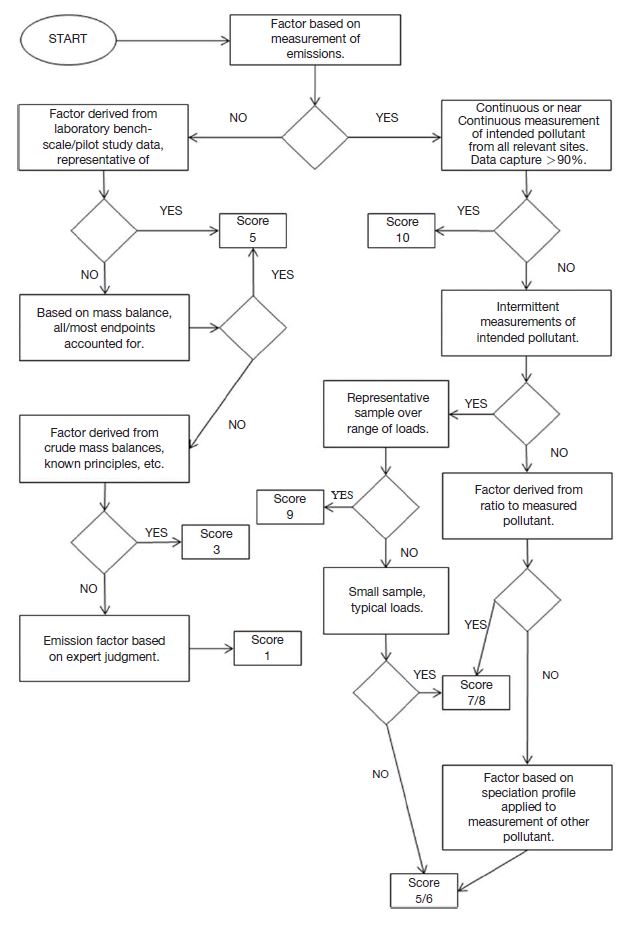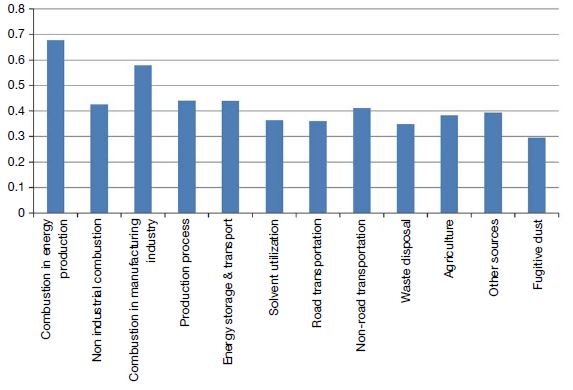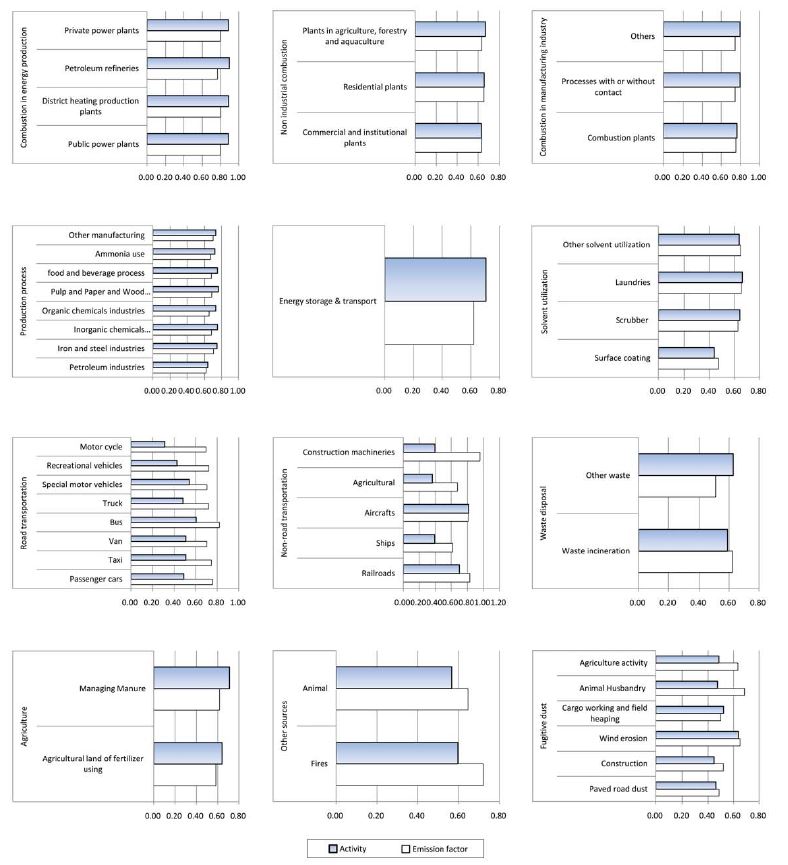
Uncertainty Assessment for CAPSS Emission Inventory by DARS
Copyright © 2014 Korean Society for Atmospheric Environment
The uncertainty assessment is important to improve the reliability of emission inventory data. The DARS (Data Attribute Rating System) have recommended as the uncertainty assessment technic of emission inventory by U.S. EPA (Environmental Protection Agency) EIIP (Emission Inventory Improvement Program). The DARS score is based on the perceived quality of the emission factor and activity data. Scores are assigned to four attributes; measurement/method, source specificity, spatial congruity and temporal congruity. The resulting emission factor and activity rate scores are combined to arrive at an overall confidence rating for the inventory. So DARS is believed to be a useful tool and may provide more information about inventories than the usual qualitative grading procedures (e.g. A through E).
In this study, the uncertainty assessment for 2009 CAPSS (Clean Air Policy Support System) emission inventory is conducted by DARS. According to the result of this uncertainty assessment, the uncertainty for fugitive dust emission data is higher than other sources, the uncertainty of emission factor for surface coating is the highest value, and the uncertainty of activity data for motor cycle is the highest value. Also it is analysed that the improvement of uncertainty for activity data is as much important as the improvement for emission factor to upgrade the reliability of CAPSS emission inventory.
Keywords:
DARS, Uncertainty assessment, CAPSS, Emission inventory1. 서 론
현재 국립환경과학원에서 운영하는 대기정책 지원 시스템 (CAPSS)은 최근 배출계수를 이용하여 모델링에 활용할 수 있는 지자체 단위별 격자별 배출량을 산출하고 있다. CAPSS에서 산출되는 배출자료는 수도권 대기환경 개선에 관한 특별법의 시행과 이에 따르는 총량규제 그리고 지자체의 시행계획 평가 등에 없어서는 안 되는 중요한 기초자료로 활용되고 있다. 또한, 2015년부터는 PM2.5의 대기환경기준이 적용될 예정이어서 이에 관련된 배출 자료의 중요성이 높아지고 있다. 국가 대기오염 배출자료는 대기관리 정책 수립의 필수적인 기초자료이며, 정책의 성과를 평가하기 위한 주요한 도구이다. 최근 수도권 대기질 개선법과 총량규제의 시행에 따라 대기오염 배출자료의 신뢰도를 높이는 것은 매우 중요하고 시급하다.
그동안 국내 대기오염 분야의 불확도 평가는 Cho et al. (2012), Kim et al. (2008)와 다수의 연구 논문들(Lee et al., 2002; Jeong et al., 2001)이 주로 대기오염과 온실가스 측정분야를 중심으로 이루어졌다. 대기오염 배출자료에 대해서는 Jang et al. (2005)이 DARS에 의한 평가기법을 처음 국내 배출자료 불확도 평가에 이용한 바 있다. 그러나 이 연구는 중분류의 배출원에 대하여 분석한 결과로 상세한 분석 결과를 얻기에는 부족하였다.
국내 배출자료에 대한 불확도 평가는 주로 대형 배출시설을 중심으로 한 점오염원의 배출계수에 대해서는 미국 EPA의 AP-42와 유사한 등급평가 방식을 이용하여 평가 작업을 하였다. 그러나 면오염원과 이동오염원에 대해서는 평가가 제대로 이루어지지 못하였고 기존 등급평가 방식이 배출계수에만 적용되어 활동도 자료에 대한 평가가 이루어지지 못하였다.
본 연구에서는 미국 EPA의 대기오염 배출자료 불확도 평가 추천 방법인 DARS (Data Attribute Rating System)을 이용하여 2009년 기준 CAPSS 248개 소분류 배출원의 배출자료를 대상으로 배출계수와 활동도에 대하여, 공간 및 시간 속성의 적합성 등 4가지 속성으로 구분하여 불확도 평가를 실시하였다. 그리고 DARS 평가 결과를 분석하여 배출원별, 오염물질별 불확도의 수준을 평가하고 신뢰도 개선이 우선적으로 필요한 배출원을 분석하였다.
2. 배출자료의 불확도 평가방법
대기오염 배출자료의 불확도 평가 기법은 배출자료의 양과 질에 따라 다양한 방법론의 적용이 가능하다. 배출정보의 작성 및 편찬 단계에서의 자료 검증 및 평가로부터 모델링을 활용해야 하는 것까지 복잡성의 단계가 다양하게 존재하기 때문에 현실적으로 적용가능하며 지속적인 활용도를 고려한 방법론을 이용해야 한다. 미국 EPA의 EIIP (Emission Inventory Improvement Program)의 Technical report series Volume 6에서 소개하고 있는 대기오염 배출자료의 불확도 평가에 이용되는 여러 기법의 특징과 장단점을 정리하면 표 1과 같다.
미국 EPA의 AP-42의 배출계수 등급 평가 방법은 비교적 손쉬운 주관적 자료품질 평가방법의 하나로써 배출계수의 산출에 사용된 측정 데이터에 대하여 등급을 부여하고, 그 데이터를 활용한 배출계수에 주관적인 등급 표시를 하고 있다. 측정 데이터에 대한 등급은 A, B, C, D의 4등급으로 구분되어 있으며, 측정 데이터에 대한 등급부여가 수행되면 이를 기초로 배출계수에 대하여 A부터 E까지 총 5단계로 등급평가 작업이 이루어진다.
이 등급평가 방법에 의한 국내 CAPSS의 배출자료 산출에 적용된 배출계수의 평가 현황은 주로 점오염원에 대하여 이루어졌으며 그 결과는 표 2와 같다. 배출계수 등급평가 결과를 대기오염물질별로 살펴보면 SOx 배출계수가 A, B 등급의 비율이 가장 많아 가장 신뢰도가 높은 반면, A 등급이 거의 없고 대부분이 C 등급인 PM10 그리고 대부분 E 등급 평가를 받고 있는 NH3의 배출계수들이 평가 등급이 낮아 신뢰도가 낮은 것을 알 수 있다.
자료속성 평가 시스템인 DARS (Beck et al., 1994)는 미국 EPA에 의하여 1994년 제안된 불확도 평가 방법으로 EIIP에 의하여 반정량적 자료품질순위 방식(Semiquantative Data Quality Rankings)의 추천 방식(Preferred method)으로 제안되어 있으며 Frey (2007, 1998), Frey and Li (2003)와 Kumar et al. (2004)의 연구에서 활용된 바 있다.
DARS 평가의 가장 좋은 점은 국내에서 기존에 가장 많이 이용한 AP-42의 배출계수 등급평가 방법이 배출계수 산출과정에 대한 평가에 국한되어 있는 반면 DARS 평가는 배출계수 뿐만 아니라 활동자료에 대한 평가도 실시하며 자료의 대표성, 측정방법, 시공간 적합도 등을 종합적으로 평가할 수 있다. 또한 평가에 걸리는 노력도 표 1에 제시된 바와 같이 상대적으로 중간 정도의 시간(500시간 이내)이 소요된다는 장점이 있다.
3. 연구 범위 및 방법
3. 1 연구 범위
본 연구의 대상 배출원은 2009년 CAPSS에서 배출량을 산출하고 있는 대분류 12개, 중분류 48개, 소분류 248개를 대상으로 하여 배출원별로 배출계수 속성, 활동도 속성, 시간 속성, 공간 속성으로 구분한 DARS의 불확도 평가 방법을 적용하여 오염물질별 불확도 평가를 실시하였다.
3. 2 연구 방법
DARS는 미국 EPA, EIIP (Emission Inventory Improvement Program)에서 추천하는 불확도 평가 시스템이다. DARS는 표 3과 같이 배출자료의 신뢰도에 영향을 주는 속성을 측정의 적합성, 오염원의 대표성, 공간 및 시간속성의 적합성 등 4가지 속성으로 구분하여 배출계수와 활동도 자료의 불확도를 평가한다. 불확도는 0~1로 표현되며 점수가 낮을수록 불확도가 높아 자료의 신뢰도가 낮은 것으로 평가한다. 속성별 배출자료의 불확도는 배출계수와 활동도의 불확도의 곱으로 나타내며, 이를 4가지 자료의 속성에 대하여 평가한 후 전체의 평균치가 해당 배출자료의 불확도를 나타낸다. 따라서 DARS 점수는 총 8개 항목에 대하여 각각의 배점 기준을 가지고 점수를 산정하게 된다. 평가 과정을 단계별로 정리하면 다음과 같다.
DARS 점수를 부여하기 위해서는 각 오염원 별로 배출계수와 활동도 자료에 대하여 공통양식에 의한 자료가 정리되어야 한다. 이에 따라 각 부문별로 배출원 분류코드, 배출량 현황, 산출 방법론, 배출계수와 산출과정, 참고문헌, 활동도 자료, 시공간 profile, 물질별 profile, 불확도 평가 결과, 작성 및 수정일자에 대하여 정리하여 불확도 평가의 기초자료로 활용하였다.
DARS 점수는 총 8개 속성에 대하여 점수를 부여한다. 8개 속성은 배출계수와 활동도 자료에 대하여 측정방법, 배출원 분류특성, 공간해상도, 시간해상도에 대하여 정밀도, 대표성, 신뢰도 등을 그림 1과 같은 평가 흐름도에 따라 평가하고 1부터 10점의 속성별 점수를 부여한다. 평가는 배출계수에 대한 평가를 먼저 하고, 이어서 활동도에 대한 평가를 실시한다. 이때 기존 AP-42의 배출계수 등급 점수는 DARS 평가에서 배출계수의 측정 속성 평가 점수를 표 4와 같이 환산하며 적용할 수 있도록 DARS 평가 지침에서 권고하고 있다.
DARS에 의한 불확도 평가 과정은 배출원에 따라 총 4차에 걸쳐 31명의 전문가가 참여하여 전 배출부문에 대한 집중토의와 점수표 작성을 통하여 평가 작업을 실시하였다. 1차 DARS 평가는 비산먼지, 농업, 기타 면오염원에 대한 평가를 실시하였으며, 2차는 연료연소, 3차는 도로, 비도로 이동오염원, 4차는 산업공정과 폐기물에 대한 평가를 실시하였다.
평가 흐름도에 따라 8개 항목에 대하여 산출한 점수를 10으로 나누고 이 값들을 표 2와 같은 형태로 정리한다. 그리고 측정방법, 배출원 분류, 공간, 시간 해상도 속성별 배출계수와 활동도 자료의 값을 곱하여 속성별 점수를 내고 이를 평균하여 부문별 배출량 산출자료의 DARS 점수를 산정하게 된다. 이때 배출계수와 활동도 자료의 속성별 점수를 평균하면 배출원에 대한 배출계수, 활동도 자료의 DARS 점수가 산정된다.
4. DARS 평가 결과와 분석
4. 1 배출원별 DARS 평가 결과
DARS 평가를 위한 평가표는 배출원 특성자료와 같이 배출원별로 작성하였으며, 평가를 위한 전문가 소속과 이름, 서명으로 작성하였다. 속성에 따른 평가표는 배출원 소분류까지 구분하여 측정 속성, 배출원 속성, 공간 속성, 시간속성 4가지 속성과 활동도에 대하여 대기오염물질별 점수를 작성하도록 하였다. 또한 각 배출원에 대한 개선 필요사항도 함께 작성하도록 하였다.
중분류 배출원의 오염물질별 배출계수에 대한 불확도 평가 결과 배출계수의 DARS 평균 점수는 CO, NOx, SOx는 0.71, TSP, NH3는 0.70, PM10과 VOC는 0.67로 평가되었다. 활동도에 대한 불확도 평가 결과 활동도의 DARS 평균 점수는 0.63으로 평가 되었다.
배출계수 점수와 활동도 점수의 곱으로 평가되어지는 중분류 배출원의 배출자료의 DARS 평균 점수는 SOx 0.47, CO 0.47, NOx 0.45, VOC 0.44, PM10 0.43, NH3 0.42로 평가되어 PM10과 NH3의 불확도가 다른 오염물질보다 큰 것으로 나타났다.
대분류 배출원별 DARS 평가 점수는 그림 2와 같이 에너지 산업연소에서 0.68로 가장 높게 평가 되었으며, 비산먼지 부문이 0.29로 가장 낮게 평가 되었다. 그림 3과 같이 소분류 배출원별 배출계수와 활동도에 대한 DARS 평가 결과 에너지 산업연소, 제조업연소, 생산공정, 에너지 수송 및 저장, 농업 부문에서는 배출계수의 평가 점수가 활동도 점수보다 낮게 나타났다. 반면에 도로이동오염원, 기타 면오염원에서는 활동도 점수가 배출계수 점수보다 낮게 평가되었다. 비산업연소는 상업 및 공공기관시설의 경우 활동도, 그 외 배출원은 배출계수에 대한 점수가 낮게 평가되었다. 유기용제 사용 부문에서는 도장시설과 기타 유기용제 사용에서 활동도 점수가 낮게 평가되었으며, 비도로이동오염원에서는 항공을 제외한 배출원에서 활동도 점수가 낮게 평가되었다. 폐기물 처리 부문에서는 소각의 경우 활동도, 기타 폐기물은 배출계수에 대한 점수가 낮게 평가되었으며, 비산먼지 부문에서는 하역 및 야적을 제외한 배출원에서 활동도에 대한 점수가 낮게 평가 되었다.
배출계수와 활동도, 배출량에 대한 불확도 평가 결과 표 5와 같이 배출계수의 경우 불확도가 가장 큰 배출원은 유기용제 사용의 도장시설 부문이며, 비산먼지 도로재비산먼지, 하역 및 야적 순으로 평가 되었다. 활동도의 경우는 도로이동오염원 이륜차 부문에서 불확도가 가장 큰 것으로 평가 되었으며, 비도로 이동오염원의 농업기계, 선박 순으로 평가 되었다. 배출량의 불확도는 배출계수와 같이 유기용제 사용의 도장시설 부문에서 불확도가 가장 큰 것으로 나타났으며, 도로이동오염원의 이륜차, 비산먼지 도로재비산 순으로 평가 되었다.
4. 2 오염물질별 DARS 평가결과
불확도 평가를 통한 오염물질별로 불확도를 평가한 결과 표 6과 같이 VOC의 경우 유기용제 사용 도장 시설이 불확도가 가장 큰 것으로 평가되었으며, 그 외 오염물질에서는 도로이동오염원 이륜차가 불확도가 가장 큰 것으로 평가 되었다. 배출원 중에서 불확도가 큰 이유는 폐기물처리 부문의 기타폐기물은 VOC배출계수에 대한 불확도가 크기 때문이며, 그 외 배출원에서는 활동도에 대한 불확도가 크기 때문이었다. 따라서 대부분 배출자료의 개선을 위해서는 활동도에 대한 개선이 더 필요한 것으로 나타났다.
4. 3 배출 기여도를 고려한 배출자료 불확도와 개선 우선 순위 분석
대기오염 배출자료의 불확도 평가결과는 신뢰도 개선 우선순위를 평가하는 데 활용될 수 있을 것이다. 따라서 불확도 개선 우선순위 평가를 위하여 중분류 배출원별 배출기여도와 DARS를 이용한 배출량에 대한 불확도 평가 점수를 이용하여 배출원별 개선 우선순위를 평가 하였다. 배출가중치 불확도값은 배출기여도가 크면서 불확도가 클수록 큰 값을 갖게 되어 배출원별 배출자료 개선을 위한 우선순위가 높음을 나타내게 된다.
배출 가중치 불확도=배출 기여도(%) × (1-배출량에 대한 불확도 평가 점수)
배출가중치 불확도가 큰 20개의 배출원과 오염물질 순위는 표 7과 같다. 이를 살펴보면 농업 분뇨관리의 NH3에 대한 배출가중치 불확도가 43.82로 가장 높게 평가되었으며, 유기용제사용 도장시설의 VOC, 비산먼지 도로재비산의 PM10순으로 우선 순위가 높은 것으로 평가 되었다. 즉 이들 배출원과 오염물질은 배출량이 높은 비중을 차지하는데도 불구하고 배출자료의 불확도가 높다는 것을 의미하며 현재 CAPSS 배출자료의 신뢰도를 개선하기 위해서는 분뇨관리의 NH3, 도장시설의 VOC, 도로재비산의 PM10배출자료 개선이 시급하다는 것을 보여준다.
5. 결 론
본 연구에서는 대기오염 배출자료의 정량적 신뢰도 평가지표에 의한 불확도 평가를 통하여 기존 대기오염 인벤토리의 불확도 수준을 평가하고 신뢰도 개선을 위한 우선순위를 분석하고자 하였다.
불확도 평가대상 대기오염 배출자료는 2009년 기준 CAPSS 배출자료의 대분류 12개, 중분류 48개, 소분류 248개를 대상으로 평가를 실시하였으며, 불확도 평가기법은 미국 환경청 EIIP에서 추천하는 불확도 평가 시스템인 DARS를 이용하여 배출계수와 활동도 자료에 대한 불확도 수준을 평가하였다. DARS 평가 과정은 우선 수개월에 걸쳐 평가에 필요한 항목을 정해진 형식에 따라 정리하여 평가자료를 작성하였으며, 총 4차에 걸쳐 31명의 관계 전문가가 참여하여 전 배출부문에 대한 집중토의와 점수표 작성을 통하여 평가 작업을 실시하였다. 또한 DARS 평가 결과를 활용하여 배출자료 개선을 위한 우선순위를 분석하였다. 본 연구의 주요 불확도 평가 결과와 시사점은 다음과 같다.
1) 오염물질별 불확도 평균 점수는 SOx 0.47, CO 0.47, NOx 0.45, VOC 0.44, PM10 0.43, NH3 0.42로 평가되어 PM10과 NH3가 다른 오염물질보다 불확도가 큰 것으로 나타났다.
2) 배출계수와 활동도에 대한 불확도 평가 결과 배출계수의 불확도 평균 점수는 CO, NOx, SOx는 0.71, TSP, NH3는 0.70, PM10과 VOC는 0.67로 평가 되었으며, 활동도에 대한 불확도 평균 점수는 0.63으로 평가 되었다. 이는 국내 배출자료는 배출계수보다는 활동도 자료의 불확도가 커서 배출자료 개선을 위해서는 전반적으로 활동도 자료의 개선이 더 필요하다는 것을 보여준다.
3) 대분류 배출원에 대한 DARS 불확도 평가 결과 에너지 산업연소 배출원이 0.68로 불확도가 가장 작게 평가 되었으며, 비산먼지 배출원이 0.29로 불확도가 가장 큰 것으로 평가 되었다.
4) 중분류 배출원별 불확도 평가 결과, 배출계수의 경우 불확도가 가장 큰 배출원은 유기용제 사용의 도장시설 배출원이며, 비산먼지의 도로재비산먼지, 하역 및 야적 순으로 평가 되었다. 활동도의 경우는 도로이동오염원 이륜차, 비도로 이동오염원의 농업기계, 선박 순으로 불확도가 높은 것으로 평가 되었다.
5) 오염물질별 가장 불확도가 큰 배출원은 VOC의 경우 유기용제사용 도장시설 부문이며 그 외 오염물질에서는 도로이동오염원 이륜차로 평가 되었다. 이들 불확도가 큰 배출원은 배출계수의 불확도 보다 활동도의 불확도가 커서 배출자료 개선을 위해서는 활동도 자료의 개선이 필요한 것으로 평가되었다.
6) 중분류 배출원별 오염물질 배출 기여도와 DARS의 불확도 평가 점수를 적용하여 배출 가중치 불확도를 평가한 결과 농업 부문의 분뇨관리의 NH3, 유기용제사용 도장시설의 VOC, 비산먼지 도로재비산의 PM10 순으로 점수가 높았다. 이 결과는 이들 배출원과 오염물질이 배출량이 높은 비중을 차지하는데도 불구하고 배출자료의 불확도가 높다는 것을 의미하며 이는 배출자료 신뢰도 개선을 위해서는 이에 대한 개선작업이 우선적으로 필요하다는 것을 시사한다.
국내 대기오염 분야에서 측정자료에 대한 불확도 평가와 관리는 많이 이루어지고 있으나 배출자료에 대한 불확도 평가는 매우 부진한 상황이다. 이에 미국 환경청의 DARS를 이용하여 기존 CAPSS 배출자료의 배출계수와 활동도에 대한 불확도 평가는 현재와 개선 후의 불확도 수준을 좀더 객관적인 지표로 관리할 수 있을 것으로 기대된다. 또한 이러한 분석은 많은 시간과 노력이 필요한 대기오염 배출자료 신뢰도 개선 작업의 우선 순위를 가늠할 수 있도록 하여 배출 인벤토리 관리에 기초자료로 활용될 수 있을 것이다.
Acknowledgments
이 논문은 한국환경산업기술원의 2011년 차세대 에코이노베이션 사업 “대기오염 배출 인벤토리 개선 및 신뢰도 향상 기술 개발(1차년도)”의 지원으로 수행되었습니다.
References
- Beck, L., R. Peer, L. Bravo, Y. Yan, A Data attribute rating system. Presented at the air and waste management association’s emission inventory conference, Raleigh, North Carolina, (1994).
- Cho, C.S., S.J. Kim, S.G. Lee, U.C. Jeon, Evaluation of Measurement Uncertainty for Nitrous Oxide to QA/QC, proceeding of the 54th meeting of KOSAE, (2012), 82.
- EIIP, Recommended approach to using the data attribute rating system (DARS), EIIP Technical report series, 6, Appendix F.
- EIIP, Technical report series Volume 6, Evaluating the uncertainty of emission estimates.
- Frey, H.C., Methods for quantitative analysis of variability and uncertainty in hazardous air pollutant emissions, Proceedings of the 91st annual meeting, air and waste management association, Pittsburgh, Pennsylvania, (1998).
-
Frey, H.C., S. Li, Methods for quantifying variability and uncertainty in AP-42 emission factors, J. Air Waste Manage Assoc, (2003), 53, p1436-1447.
[https://doi.org/10.1080/10473289.2003.10466317]

- Frey, H.C., Quantification of uncertainty in emission factors and inventories, Proceedings of the 16th annual international emission inventory conference, Raleigh, (2007).
- Kim, H.S., S.A. Lee, S.M. Lee, Sensitivity and Uncertainty Analysis of Methane Emission from Landfills in Korea, proceeding of the 47th meeting of KOSAE, (2008), p471-472.
- Korea Environmental Industry & Technology Institute, Improvement of air pollution emission inventory and its reliability, (2011).
-
Kumar, S., A.N. Mondal, S.A. Gaikwad, S. Devotta, R.N. Sing, Qualitative assessment of methane emission inventory from municipal solid waste disposal sites, Atmos Environ, (2004), 38, p4921-4929.
[https://doi.org/10.1016/j.atmosenv.2004.05.052]

- Jang, Y.G., G. Kim, J. Kim, Y.M. Heo, D.Y. Kim, J.H. Hong, Assessment of Uncertainty of Air Pollutant Emission Data Using DARS Score, proceeding of the 39th meeting of KOSAE, (2005), p231-232.
- Jeong, G.B., J.C. Woo, J.H. Lee, Development of a Candidate Equipment for Ozone SRP and its Uncertainty Evaluation, J. Korean Soc. Atmos. Environ, (2001), 17(4), p313-319, (in Korean with English abstract).
- Lee, J.H., J.M. Lym, J.C. Woo, Evaluation of Uncertainties in the Measurement of Ambient NO2 Level, J. Korean Soc. Atmos. Environ, (2002), 18(5), p355-362, (in Korean with English abstract).
- National Institute of Environmental Research, Clean air policy support system (CAPSS), (2010).
- National Institute of Environmental Research, Guideline of national air pollutant emission inventory, (2010).



